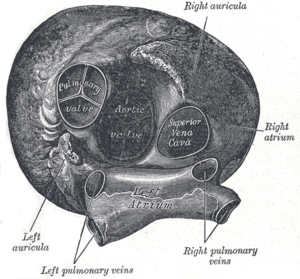Left atrium
| Left atrium | |
|---|---|
.svg.png) | |
| Anterior (frontal) view of the opened heart. White arrows indicate normal blood flow. | |
 | |
| Computer rendering of a human left atrium. | |
| Latin | atrium sinistrum |
| Artery | circumflex branch of left coronary artery |
| Vein | oblique vein of the left atrium |
The left atrium is one of four chambers in the human heart. It receives oxygenated blood from the pulmonary veins, and pumps it into the left ventricle, via the mitral valve. Atria facilitate circulation primarily by allowing uninterrupted venous flow to the heart, preventing the inertia of interrupted venous flow that would otherwise occur at each ventricular systole.[1]
Size
| Women | Men | |
|---|---|---|
| Diameter (mm) | 27–38 | 30–40 |
| Volume (ml) | 22–52 | 18–58 |
| Volume/BSA (ml/m²) | 16–28 | 16–28 |
| BSA, body surface area | ||
Foramen ovale
There is a foramen ovale (oval hole) between the right and left atrium in the fetus. After birth, this should close. If it does not, this is an atrial septal defect (hole in the heart). In the fetus, the right atrium pumps blood into the left atrium, bypassing the pulmonary circulation (which is useless in a fetus). In an adult, a septal defect would result in flow in the reverse direction - from the left atrium to the right - which will reduce cardiac output, potentially cause cardiac failure and in severe or untreated cases, death.
Blood supply
The left atrium is supplied mainly by the left circumflex coronary artery, though the branches are too small to be identified in a cadaveric human heart and are not named.
The oblique vein of the left atrium is partly responsible for venous drainage; it derives from the embryonic left superior vena cava.
Animals
Many other animals, including mammals, also have four-chambered hearts, and have a left atrium. The function in these animals is similar. Some animals (amphibians, reptiles) have a three-chambered heart, in which the blood from each atrium is mixed in the single ventricle before being pumped to the aorta. In these animals, the left atrium still serves the purpose of collecting blood from pulmonary veins.
References
- ↑ Anderson, RM. The Gross Physiology of the Cardiovascular System (2nd ed., 2012). See "Chapter 1: Normal Physiology."
- ↑ Lang, RM; Bierig M, Devereux RB, Flachskampf FA, Foster E, Pellikka PA, Picard MH, Roman MJ, Seward J, Shanewise J, Solomon S, Spencer KT, St John Sutton M, Stewart W (March 2006). "Recommendations for chamber quantification". European Journal of Echocardiography 7 (2): 79–108. doi:10.1016/j.euje.2005.12.014. PMID 16458610. Retrieved 2012-08-26.
Additional images
-

Heart seen from above.
-

Base and diaphragmatic surface of heart.
-
Left atrium
